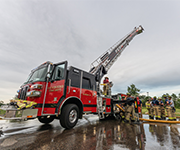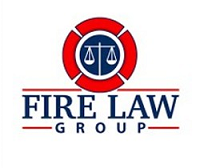The Center for Public Safety Excellence (CPSE) accredited 63 agencies and designated 688 new officers in 2024. We'd like to share a list of those individuals and agencies from Texas who achieved this noteworthy accomplishment.

Voting for the Valor, Fire Chief of the Year, Fire Safety, and Lone Star Achievement Awards is now open through Friday, January 31. Click the link below to to learn more about the nominees and cast your department’s vote.

In May 2024, Texas A&M Engineering Extension Service (TEEX), along with its research partners, conducted a series of tests to determine the contamination produced by lithium-ion (Li-ion) batteries and its impact on first responders and their personal protective equipment (PPE).

NFPA (1/18/2025)
NFPA’s wildfire expert discusses their perspectives on the LA wildfires and the response to the disasters.

Fire Rescue 1 (1/29/2025)
Company officers can use after-action reviews to reflect on interactions with their teams, particularly after an employee counseling or disciplinary session.

Wildfire Today (1/28/2025)
Firefighters have to make split-second decisions due to the work's high-risk and fast-paced nature, which has led to a number of legal protections for them.

Texas Division of Emergency Management (1/28/2025)
Governor Greg Abbott is mobilizing Swiftwater Rescue Boat Squads to assist with flood rescues ahead of potential heavy rainfall and flash flooding.

CBS News (1/26/2025)
Henderson County's Tool Fire and Rescue's budget is only $75,000, which is significantly below the volunteer fire department's costs of upgrading outdated equipment in the department.

Kaufman County News (1/22/2025)
Following the resignation of Fire Chief Derek Briggs, the City of Forney appointed John Holcomb, a dedicated member of the department since 2010, as the interim fire chief.

 
|

|

The House State Affairs Committee has released their interim report, which contains a portion on the Panhandle Wildfires.
Charge V: Panhandle Wildfires (pg. 80)
RECOMMENDATIONS
Infrastructure Improvements
- Regulatory Oversight and Monitoring: The Legislature recommends increased regulatory oversight for utility and oil and gas operators to enforce strict maintenance and replacement schedules for power poles and electrical infrastructure. The PUC should conduct studies on existing pole inspection programs and consider additional oversight measures, includingmandatory third-party audits of inspection practices. The Legislature should consider mandating more frequent pole inspections and quicker pole replacement initiatives. Legislative action is necessary to establish clear accountability and impose penalties for non-compliance with maintenance standards.
- Fire Mitigation Strategies: The Legislature recommends increased funding for fire mitigation methods, such as fire breaks, mob grazing, and pre-suppression lines should be considered. The Legislature should also consider incentivizing the underground installation of power lines in high-risk areas to minimize the risk of power pole fires during extreme weather events. Property owners should participate in fire mitigation programs in regions susceptible to wildfires, promoting community-wide engagement in fire prevention.
Support for Firefighting Resources
- Aerial Firefighting Resources: The Legislature must look at acquiring and controlling its own fleet of aerial firefighting resources, including fixed-wing and rotary-wing aircraft, either by outright ownership or by rental contract agreement. Relying solely on federal contracts for aerial firefighting assets proved ineffective, resulting in significant delays responding to the wildfires. Establishing state-owned aircraft or additional aircraft contracts will improve response times and provide immediate resources during a fire event. When looking at this recommendation, the Legislature should examine a cost-benefit analysis of owning versus contracting aircraft. Additional investments in water reloading facilities across the Panhandle should also be prioritized to support aerial operations.
- Increased Funding for VFDs: The Texas Rural VFD Assistance Program should receive increased funding to more fully cover the $43.7 million in grant requests received annually, addressing the $22 million shortfall. Furthermore, a new grant program tailored specifically for smaller VFDs serving large geographical areas should be considered, ensuring these departments receive adequate support. The grant application process must be simplified, and the metrics used to award grants should prioritize rural VFDs with the most significant geographical risk. The Legislature should examine whether (77)R H.B 2604 grants should be modified with more funding. The Legislature should also determine how to deal with the $200 million backlog of these grants.
- Job Protection for Volunteer Firefighters: Legislation to protect volunteer firefighters from job loss due to their participation in emergency response activities is essential. Volunteer firefighters should not have to choose between protecting their communities and losing their jobs. The Legislature should look at amending section 201.012, Labor Code (the Texas Unemployment Compensation Act), to exclude from the definition of “misconduct” absence from or tardiness to work resulting from responding to a declared natural disaster for up to 14 days in any calendar year. This change would allow terminated firefighters to obtain immediate compensation to help alleviate the burdens of unexpected job loss.
- Utilizing technology: The Legislature should promote the use of more advanced technology in the PUC and RRC’s wildfire prevention efforts. Since the PUC and RRC have limited resources, they should utilize technology to increase reporting and response times so that they can more quickly respond to hazardous conditions that pose wildfire threats in order to timely resolve those threats.
Communication and Coordination
- Modernization of Communication Systems: A statewide upgrade of communication equipment is essential to ensure interoperable communication among VFDs, first responders, and state agencies during wildfire events. This includes funding to replace outdated radios with broadband-enabled, digital systems that offer better interoperability and coverage and developing an inventory of firefighting equipment to improve response coordination. Upgraded communication equipment is essential to enable first responders in Texas to be able to communicate with one another during times of emergency. A state-managed communication system should be considered to ensure seamless connectivity between agencies and responders.
- Enhanced Coordination and Training: Improved coordination between local responders and state agencies is crucial. TAMFS and VFDs should conduct annual joint training exercises to build familiarity and cooperation. Legislative action should establish a mandate for such training sessions, ensuring standardized protocols and fostering trust between agencies. A clear chain of command that prioritizes VFDs in local response management must also be established.
- Enhanced Predictive Analysis Capabilities: TAMFS should adopt innovative technologies, such as drones, mobile devices, and real-time fire modeling, to improve fire prediction accuracy.
The Legislature should consider whether funding should be allocated for the acquisition of new technology to strengthen predictive analysis capabilities and better prepare Texans from future wildfires.
Other Considerations
- Access to Right-of-Ways and Easement Regulations: The Legislature should explore easement laws and easement agreements to look at ways to permit utilities to take proactive mitigation steps on private property. Easier access to perform mitigation activities will reduce risks posed by aging infrastructure.
- Prohibit Utility Rate Increases: The Committee recommends that the Legislature, in conjunction with the PUC, explore any and all available measures to prohibit or mitigate increases in utility rates to recoup funds spent for wildfire-related losses and liabilities.
View the full report HERE.
The Texas Commission on Fire Protection respectfully submits for consideration its FY2026-27 Legislative Appropriations Request and seven exceptional items, which total $1,651,577.61 in increased appropriations. The commission is fully committed to careful and prudent stewardship of the funds provided for its operations and adheres to the statewide philosophy that all agencies are to be efficient and accountable. The commission has prepared its LAR in accordance with the instructions issued by the Governor’s Office and Legislative Budget Board.

TCFP offers “regional meetings” throughout the year in a variety of locations around the state. These meetings are opportunities for members of nearby fire departments and other regulated entities to meet some of our staff in person. We want to answer your questions, listen to your concerns, and give timely updates related to commission news. In addition, through a partnership with TEEX, CE will be awarded for your attendance at these meetings.
For a list of all upcoming meeting dates, visit the Regional Meetings webpage.
Rick Randall Upcoming Training
February 25-26
Texarkana
Resilience Strategies for First Responders (8 a.m. - 4 p.m.)
Moving Right of Bang: Critical Incident Early Intervention Strategies (8 a.m. - 12 p.m.)
This update covers the following:
- Lt. Governor Announces Senate Committee Appointments
- Proposed State Budget Released
- Federal Infrastructure Bill Update

For course descriptions and current schedule, location, and registration information, see the individual course pages on the TEEX website.
In this episode of Fire Law Roundup for January 27, 2025, Brad and Curt discuss the refiling of a LODD suit against Baltimore; a suit by Louisville firefighters claiming the city reneged on an agreement with regard to medical marijuana use; a retaliation suit brought by a San Antonio battalion chief over ADA and GINA issues; manslaughter charges against a Sioux City medic; and an overtime suit brought by firefighters in Colorado.

 Each January, we honor Firefighter Cancer Awareness Month. It’s a time to recognize the impact of occupational cancer in the fire service, including supporting firefighters diagnosed with cancer and advancing efforts to prevent firefighter cancer. Each January, we honor Firefighter Cancer Awareness Month. It’s a time to recognize the impact of occupational cancer in the fire service, including supporting firefighters diagnosed with cancer and advancing efforts to prevent firefighter cancer.
During this month, we ask you to share the NFR as one thing firefighters can do to help understand and prevent cancer in the fire service. It only takes 5 minutes to get started.
Our digital toolkit for Firefighter Cancer Awareness Month provides materials to help you share the NFR, including:
- social media posts and images
- web banners
- an email or newsletter template
- a QR code
We’ve also created videos you can download to share on social media, emphasizing how quickly firefighters can get started with their NFR registration. These videos are attached in a zip file.
We can also send you professionally printed materials (e.g., posters, fact sheets, palm cards) if you are interested. Just let us know how many and where to send them.
Thousands of firefighters from all 50 U.S. states have joined the NFR – and we still need more to join to reach our goal of 200,000+ U.S. firefighters enrolled.
We appreciate your continued support and the work you’ve done to help firefighters join. By sharing the NFR with your communities, you can make a lasting impact on the fire service.
|
















 Each January, we honor Firefighter Cancer Awareness Month. It’s a time to recognize the impact of occupational cancer in the fire service, including supporting firefighters diagnosed with cancer and advancing efforts to prevent firefighter cancer.
Each January, we honor Firefighter Cancer Awareness Month. It’s a time to recognize the impact of occupational cancer in the fire service, including supporting firefighters diagnosed with cancer and advancing efforts to prevent firefighter cancer.